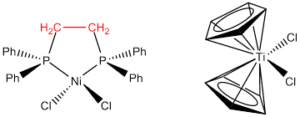Table of Contents

The amount of donor groups in a single ligand that binds to a central atom in a coordination complex is referred to as denticity. In many circumstances, just one atom in the ligand binds to the metal, resulting in a denticity of one and the ligand being described as monodentate (sometimes called unidentate). Polydentate or multidentate ligands have more than one bound atom. Denticity is derived from the Latin word dentist, which means “tooth.” The ligand is imagined to be biting the metal at one or more connection locations. A ligand’s denticity is denoted by the Greek letter “Κ”(‘kappa’).
- Denticity differs from hapticity in that hapticity only applies to ligands with continuous coordinating atoms.
- The number of electron pairs shared by the ligand with the metal atom or ion is described as its denticity.
- The number of ligand donor atoms linked to the metal atom or ion decides if the ligand is monodentate or polydentate.
Types of Ligands:
Monodentate ligands:
A monodentate ligand is one that shares an electron pair of a single donor atom with a metal atom or ion. For example: X‒ (halido), NH3 (ammine), H2O (aqua), CN‒ (Cynaido) .
Bidentate ligands:
These ligands include two donor atoms capable of attaching to a single metal cation or atom. With a metal ion, a bidentate ligand forms a 5 or 6-membered ring. Bidentate ligands include the following: H2NCH2CH2NH2 (ethane-1, 2-diamine) and C2O42‒ (oxalate).
CO32-, NO2–, NO3–, NCS–, and other ligands have two donor atoms but behave as monodentate ligands in general. They form four or three-membered rings with metal cations or atoms; repulsion between donor atoms and their electron pairs leads the ring to stain and hence become unstable.
- Tridentate ligands: Three donor atoms in these ligands can connect to a single metal cation or atom.
- Polydentate Ligands: A polydentate ligand is one that has several donor sites. For instance, N(CH2CH2NH2)3 (Nitrilotriethylamine, a tetradentate ligand ), Hexadentate ligand example; EDTA (Ethylene Diamine Tetraetato Ion).
- Ambidentate ligand: This is a ligand that can ligate across two distinct atoms. For example, the NO2 ion can coordinate to a central metal atom/ion through either nitrogen or oxygen.
The denticity of the ligands present can have an immediate impact on the stability of a metal ion complex. The chelate effect occurs when ligands with greater denticities form more stable compounds than ligands with lower denticities. Because most chelating chemicals can form stable ring structures, their stability can be ascribed to superior changes in entropy.
Also read: Important Topic of Chemistry: Entropy
FAQs
How can you determine a ligand's denticity?
A ligand's Denticity is the number of lone pairs provided to the central metal atom or ion by a ligand atom or molecule. The number of ligand donor atoms linked to the metal atom or ion decides if the ligand is monodentate or polydentate.
What is the EDTA ligand's denticity?
Ethylenediaminetetraacetate (EDTA) has a denticity of six.
Is bipyridine a non-reactive ligand?
Bipyridine is a denticity two and is a neutral ligand.







